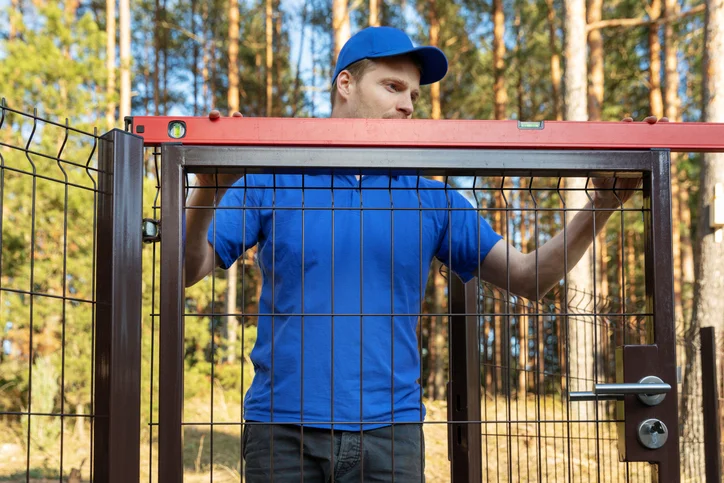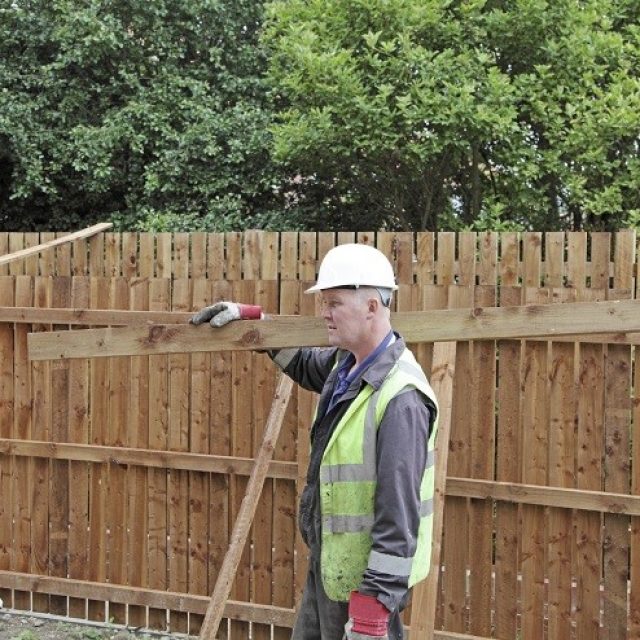Fast Fence Repair Solutions for Storm or Wind Damage
Fast Fence Repair Solutions for Storm or Wind Damage
Blog Article
How to Identify Typical Problems That Call For Immediate Fencing Repair
When it pertains to keeping your fencing, it is important to identify concerns prior to they become bigger troubles. Regularly looking for signs of decomposing wood, leaning panels, or rust can save you time and money over time. You could not realize how weather and insects can jeopardize your fencing's honesty. Allow's discover the usual indicators that suggest your fence needs prompt interest, so you can maintain your property safe and secure and looking its ideal.
Indicators of Rotting Wood in Wooden Fences
Have you discovered your wood fencing looking a bit worse for wear? It could be time to inspect for signs of rotting timber if so. Check out the base of the articles and panels for soft areas. That's a clear sign of rot if you press on the wood and it really feels spongy or collapses. Next, look for staining or dark places on the wood-- these frequently signal wetness damage. Take notice of any type of peeling off paint or coating, as this can subject the wood to further degeneration. Furthermore, a poignant, moldy scent can suggest fungal development. Don't neglect to examine connections and joints; if they're loosened or breaking down, the wood under is most likely compromised. By capturing these indicators early, you can prevent extra substantial damages and maintain your fence standing strong. Routine upkeep is key to prolonging the life of your wooden fence.
Leaning or Tilting Fencing Panels
If you've discovered your fence panels tilting or leaning, it's crucial to recognize what triggered it. This concern could indicate underlying architectural damage that requires your focus. Allow's explore the common causes and the repair work choices offered to get your fencing back in shape.

Reasons of Leaning Panels
When you see your fence panels leaning or turning, it's frequently an indicator of underlying issues that need resolving. One usual reason is inadequate drain; too much water can erode the dirt around the fencing blog posts, compromising their support. An additional culprit could be strong winds or storms that push against the panels, particularly if they're not effectively secured. Additionally, the natural settling of soil in time can create blog posts to change, leading to a tilt. Insects, like termites, can compromise the integrity of wood panels, creating them to lean. Ultimately, inadequate installment techniques might lead to panels not being safely set, leaving them susceptible to leaning under pressure. Address these concerns quickly to keep your fencing's stability.
Signs of Architectural Damages
Observing tilting or leaning fencing panels can be disconcerting, as these issues often suggest structural damages that requires instant attention. When your fencing starts to lean, it may signal that the messages are shifting or that the dirt around them has deteriorated. Pay close focus to spaces in between messages or panels, as these can additionally suggest instability. deck builder. Additionally, look for cracks or splintering in the timber, which can compromise the total structure. If you notice corrosion or corrosion on steel components, it can jeopardize the honesty of the fencing. Keep in mind, disregarding these indicators can result in more serious damages down the line, so it's necessary to evaluate the scenario quickly and do something about it before it gets worse
Repair Work Options Available

Corrosion and Rust in Metal Fences
If you possess a metal fencing, you may notice corrosion and rust creeping in with time, particularly if it's exposed to dampness. These issues not just impact the look of your fencing however can additionally jeopardize its structural stability. To identify rust, look for reddish-brown areas or patches, which show the metal is oxidizing. Rust can spread promptly if left untreated, weakening the fence and leading to costly repairs.To deal with rust and corrosion, you need to cleanse the affected locations with a cable brush and apply a rust-inhibiting guide. As soon as the primer dries, take into consideration painting the fencing with a weather-resistant paint to secure it better. Regular upkeep, such as examining for indicators of rust and touching up paint as needed, will certainly aid extend your fence's life expectancy. Addressing these issues immediately assures your steel fence remains solid and aesthetically appealing for several years to come.
Fractures and Splits in Vinyl Fence

Root Causes Of Plastic Damage
Plastic secure fencing is prominent for its longevity, yet it can still endure from fractures and divides because of various variables. One major cause is severe temperature variations. It can weaken the material over time when plastic broadens in the heat and agreements in the chilly. Additionally, direct exposure to severe sunshine can cause UV degradation, making the plastic brittle. Physical effects, like heavy branches or unintended collisions, can also develop cracks. Poor installation or utilizing low-grade materials can intensify these issues. Additionally, age contributes; older vinyl fence is more prone to damage. Normal evaluations can assist you recognize these factors before they cause significant issues. Take positive actions to guarantee your fence stays intact and strong.
Fixing Cracks Properly
Although fractures and divides in your plastic secure fencing can be worrying, resolving them promptly can prevent additional damage and maintain the fence's appearance. First, analyze the dimension of the crack. For small splits, a vinyl fixing kit frequently includes sticky that can bond the sides, supplying a seamless fix. Tidy the location completely before using the glue, guaranteeing it adheres effectively. For bigger splits, you might require to utilize a vinyl patch. Cut the spot to dimension, use glue around the edges, and press it firmly onto the split. Enable it to cure based on the supplier's directions. Regular upkeep and quick repair work can extend your fencing's lifespan, maintaining it looking great for years to come.
Loosened or Missing Fencing Messages
Missing or loosened fencing articles can undermine the security of your entire fencing structure. If you see any type of posts leaning or wobbling, it's essential to deal with the problem instantly. Inspect for any indications of movement, as this can result in more damage gradually. You can easily examine the trouble by giving each article a mild shake-- if it really feels unstable, it's time to take action.For missing articles, you'll require to replace them immediately to keep your fencing's integrity. When you set up brand-new articles, make certain they're firmly anchored in the ground with concrete or gravel for added stability. If a post hangs, tighten it by adding extra support or driving it deeper into the ground.Ignoring these problems can bring about recommended you read bigger problems, like spaces in your fencing or perhaps total collapse. So, watch on your blog posts and remain positive regarding fixings!
Damages From Weather and Natural Environment
Weather condition and natural environments can ruin your fence, leading to various kinds of damages that call for punctual focus. Hefty rain can cause wood to rot, making it weak and unstable. Snow build-up might flex or damage panels, while strong winds can root out fencing messages or cause areas to lean.If you observe fractures or splintering in wooden fencings, it signifies drying out due to intense sunlight direct exposure. At the same time, steel fences can corrosion if safety finishes diminish, especially in humid or seaside areas.Inspect your fence on a regular basis after storms or severe weather to capture any type of damage early. Resolving these concerns swiftly can save you from pricey repair services down the line. Don't wait until a little trouble turns into a significant one; stay positive and maintain your fencing in top form to keep both capability and visual appeal.
Pest Problem and Termite Damages
It's essential to act quickly to avoid additional devastation when you see signs of insect invasion or termite damage. Try to find mud tubes along your fencing or hollow-sounding timber, as these suggest termites go to job. You might also see tiny openings or frass, which is termite droppings appearing like sawdust. If you find any one of these indicators, it's time to examine the damage.Don' t delay until it's far too late; pests can jeopardize your fencing's stability. Examine the surrounding area for ants or beetles, as they may be contributing to the issue. If you presume a problem, consider calling a parasite control expert to confirm and treat the issue.Repairing or changing damaged areas of your fencing without delay not just recovers its stamina however also prevents pests from spreading out additionally. Keep alert to maintain your residential property safe and secure and pest-free.
Regularly Asked Questions
Just how Commonly Should I Evaluate My Fence for Damages?
You need to examine your fence a minimum of two times a year, ideally throughout spring and loss. Routine checks help you detect damage early, conserving you money and time on repairs while keeping your property's look and protection.
Can I Repair a Fence Myself or Work With an Expert?
If you have the right devices and skills, you can definitely repair a fencing yourself. Hiring a professional guarantees quality job and saves you time, especially for intricate repair work or extensive damage.
What Equipment Are Needed for Basic Fencing Repair Work?
For fundamental fencing repairs, you'll require tools like a hammer, screwdriver, pliers, a saw, a level, and determining tape. deck builder. Depending on the repair work, you could additionally need nails, screws, or substitute boards
Exactly How Much Does Fencing Repair Typically Cost?
Fence repair costs differ commonly, however you can anticipate to pay between $200 and $1,500 relying on materials, labor, and degree of damages. It's clever to obtain several quotes for the very best bargain.
When Is the Ideal Time of Year for Fence Repair Works?
The very best time for fence repair work is during light weather condition, usually in springtime or very early autumn. You'll avoid extreme temperature levels, making it simpler to work and ensuring the products set correctly for lasting durability (deck builder). Discovering leaning or turning fencing panels can be alarming, as these problems often indicate architectural damages that requires prompt interest. Missing or loose fence posts can threaten the stability of your entire fencing structure. Snow buildup might bend or break panels, while solid winds can root out fence messages or trigger areas to lean.If you discover fractures or splintering in wood fences, it's an indicator of drying out due to intense sun direct exposure. Metal fencings can rust if protective finishes wear off, particularly in damp or coastal areas.Inspect your fencing frequently after tornados or extreme this article climate to catch any damage early. Fence repair service expenses vary commonly, however you can anticipate to pay in between $200 and $1,500 depending on materials, labor, and degree of damage
Report this page